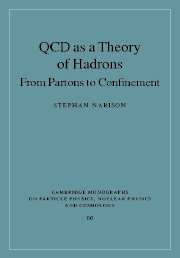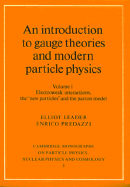QCD as a Theory of Hadrons
This book provides a pedagogical introduction to the perturbative and non-perturbative aspects of quantum chromodynamics (QCD). Introducing the basic theory and recent advances in QCD, it also reviews the historical development of the subject, covering pre-QCD ideas of strong interactions such as the quark and parton models, the notion of colours and the S-matrix approach. The author then discusses gauge theory, techniques of dimensional regularization and renormalization, deep inelastic scattering and hard processes in hadron collisions, hadron jets and e+e– annihilations. Other topics include power corrections and the technologies of the Shifman-Vainshtein-Zakharov operating product expansion. The final parts of the book are devoted to modern non-perturbative approaches to QCD and the phenomenological aspects of QCD spectral sum rules. The book will be a valuable reference for graduate students and researchers in high-energy particle and nuclear physics, both theoretical and experimental.
- A thorough and pedagogical introduction to the method of QCD spectral sum rules
- Covers the historical development of the subject as well as the progress made
- Author has excellent reputation in the field
Product details
May 2004Hardback
9780521811644
812 pages
255 × 183 × 48 mm
1.851kg
160 b/w illus. 50 tables
Temporarily unavailable - available from TBC
Table of Contents
- About Stephan Narison
- Outline of the book
- Preface
- Acknowledgements
- Part I. General Introduction:
- 1. A short flash on particle physics
- 2. The pre-QCD era
- 3. The QCD story
- 4. Field theory ingredients
- Part II. QCD Gauge Theory:
- 5. Lagrangian and gauge invariance
- 6. Quantization using path integral
- 7. QCD and its global invariance
- Part III. MS scheme for QCD and QED: Introduction
- 8. Dimensional regularization
- 9. The MS renormalization scheme
- 10. Renormalization of operators using the background field method
- 11. The renormalization group
- 12. Other renormalization schemes
- 13. MS scheme for QED
- 14. High-precision low-energy QED tests
- Part IV. Deep Inelastic Scattering at Hadron Colliders:
- 15. OPE for deep inelastic scattering
- 16. Unpolarized lepton-hadron scattering
- 17. The Altarelli-Parisi equation
- 18. More on unpolarized deep inelastic scatterings
- 19. Polarized deep-inelastic processes
- 20. Drell-Yan process
- 21. One 'prompt photon' inclusive production
- Part V. Hard Processes in e+e– Collisions: Introduction
- 22. One hadron inclusive production
- 23. gg scatterings and the 'spin' of the photon
- 24. QCD jets
- 25. Total inclusive hadron productions
- Part VI. Summary of QCD Tests and as Measurements
- Part VII. Power Corrections in QCD:
- 26. Introduction
- 27. The SVZ expansion
- 28. Technologies for evaluating Wilson coefficients
- 29. Renormalons
- 30. Beyond the SVZ expansion
- Part VIII. QCD Two-Point Functions:
- 31. References guide to original works
- 32. (Pseudo)scalar correlators
- 33. (Axial-)vector two-point functions
- 34. Tensor-quark correlator
- 35. Baryonic correlators
- 36. Four-quark correlators
- 37. Gluonia correlators
- 38. Hybrid correlators
- 39. Correlators in x-space
- Part IX. QCD Non-Perturbative Methods:
- 40. Introduction
- 41. Lattice gauge theory
- 42. Chiral perturbation theory
- 43. Models of the QCD effective action
- 44. Heavy quark effective theory
- 45. Potential approaches to quarkonia
- 46. On monopole and confinement
- Part X. QCD Spectral Sum Rules:
- 47. Introduction
- 48. Theoretical foundations
- 49. Survey of QCD spectral sum rules
- 50. Weinberg and DMO sum rules
- 51. The QCD coupling as
- 52. The QCD condensates
- 53. Light and heavy quark masses, etc.
- 54. Hadron spectroscopy
- 55. D, B and Bc exclusive weak decays
- 56. B0(s)-B0(s) mixing, kaon CP violation
- 57. Thermal behaviour of QCD
- 58. More on spectral sum rules
- Part XI. Appendix A: physical constants and unites
- Appendix B: weight factors for SU(N)c
- Appendix C: coordinates and momenta
- Appendix D: Dirac equation and matrices
- Appendix E: Feynman rules
- Appendix F: Feynman integrals
- Appendix G: useful formulae for the sum rules
- Bibliography
- Index.





